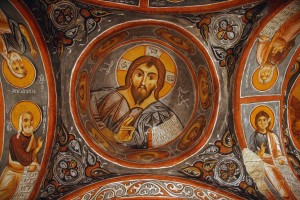OPEN-AIR MUSEUM -GÖREME
OPEN-AIR MUSEUM -GÖREME
Göreme Open Air Museum, also known as Göreme Ruins, was seen as the center of education until the 13th century. The reason for this is that the psychoposure of Kayseri, St. Basil, came to this region in the 4th century AD and started a monastic life in the valley when he began to spread his knowledge to people and to raise his own students after a while. Göreme is a rock settlement and churches, chapels, dining halls and sitting areas were carved in this settlement. The parts that can be visited in Göreme Open Air Museum are St. Basil's Chapel, St. Barbara's Chapel, Monks and Nuns Monastery, Dark Church, Tokalı Church, Çarıklı Church, Elmalı Church and Yılanlı Church. The churches in question have geometric decorations that Christians used in their early years. Göreme Open Air Museum is a must-see.
BASIL’S CHAPEL
Located at the entrance to the museum is an 11th-century chapel. Here, Hz. Portrait of Jesus, hz. Mary and St. The Childhood of Jesus is depicted. We can also see depictions of 2 saints, St. George, St. Demetrius and St. Theodore.e tasvirlerini de görebiliriz.
AZIZE BARBARA CHAPEL
The location of the chapel is behind the rock block where Elmalı Church is located. The motifs inside are depicted with red paint. Its dome and walls are decorated with rich geometric motifs. At the same time, we can see military symbols and mythological animals in these drawings. At the same time, there are depictions of St. George and St. Theodore, St. Barbara fighting with the dragon on horseback.
MONESTERY OF NUNS AND PRIETS
It is also known as the Nuns' Monastery and on the first floor there are the kitchen, dining hall and rooms. There is a chapel on the second floor. This chapel is in ruins but in a navigable condition. The connection between the floors in the monastery, which consists of three floors, is provided by tunnels. In a dangerous moment, bolt stones were used to close these tunnels. In the Monastery of Monks on the right, unfortunately, the passages between the floors were closed due to erosion. Therefore, it is possible to see only a few rooms on the ground floor.
DARK CHURCH
It is called the Dark Church because it receives very little light from a very small window in the Narthex part of the church. The fact that the church was not illuminated ensured that the frescoes inside did not fade and still remain alive. The church, which is estimated to have been built at the end of the 11th century and the beginning of the 12th century, has rich decorations. Deesis, Gospel, Journey to Bethlehem, Birth, Adoration of the Magi, Baptism, Resurrection of Lazarus, Transfiguration, Entry to Jerusalem, Last Supper, Betrayal, Prophet. Jesus on the Cross, St. Jesus' Descent into Hell, Women at the Empty Tomb, Blessing and Appointment of the Apostles, Hz. There are some scenes from the Torah, such as the Ascension of Jesus, the Hospitality of the Prophet Abraham, and the Burning of Three Jewish Youths.
BUCKLE CHURCH
The Tokalı Church, which is estimated to have been built at the end of the century and the beginning of the 11th century, is the oldest rock church in this region and consists of 4 places. The single-nave Old Church, the New Church, the church below the Old Church and the side chapel to the north of the New Church are the 4 places mentioned. Drawings from the life of St. Basil, depictions of many saints and Hz. It is possible to see the miracles of Jesus and his life cycle in the drawings on the wall.

